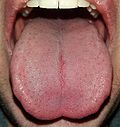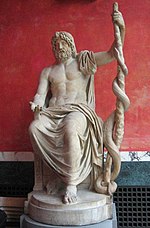Longitudinal muscle of tongue may refer to: Inferior longitudinal muscle of tongue Superior longitudinal muscle of tongue This disambiguation page lists... 154 bytes (51 words) - 13:10, 29 December 2019 |
 | The superior longitudinal muscle of tongue or superior lingualis is a thin layer of oblique and longitudinal fibers immediately underlying the mucous... 2 KB (208 words) - 09:24, 10 July 2023 |
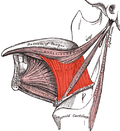 | Hyoglossus (redirect from Hyoglossus muscle) the tongue, inserting between the styloglossus and the inferior longitudinal muscle of the tongue. Structures that are medial/deep to the hyoglossus are... 3 KB (336 words) - 21:54, 3 February 2023 |
 | Glossopharyngeal nerve (category Nerves of the head and neck) glands of the posterior tongue, and the stylopharyngeus muscle (which dilates the pharynx during swallowing). The branchial motor component of CN IX provides... 19 KB (2,275 words) - 19:14, 1 January 2024 |
 | This is a table of skeletal muscles of the human anatomy, with muscle counts and other information. Skeletal muscle maps Anterior view Posterior view... 139 KB (964 words) - 20:10, 14 March 2024 |
 | Medulla oblongata (redirect from Foramen caecum of medulla oblongata) also by association to those muscles innervated, such as those of the tongue, pharynx and larynx. The medulla can be thought of as being in two parts: an... 14 KB (1,604 words) - 20:22, 10 January 2024 |
the tongue. The intrinsic muscles of the tongue (XII) contract to make a trough (a longitudinal concave fold) at the back of the tongue. The tongue is... 17 KB (2,244 words) - 21:13, 18 March 2024 |
 | Human digestive system (redirect from Accessory organs of digestion) either side of the soft palate are the palatoglossus muscles which also reach into regions of the tongue. These muscles raise the back of the tongue and also... 64 KB (8,590 words) - 07:53, 2 March 2024 |
 | Tibia (redirect from Ossification of tibia) rounded extremities of the bone; an upper (also known as superior or proximal) closest to the thigh and a lower (also known as inferior or distal) closest... 22 KB (2,708 words) - 09:45, 9 December 2023 |
 | Pharynx (redirect from Laryngeal part of the pharynx) two sets of pharyngeal muscles form the pharynx and determine the shape of its lumen. They are arranged as an inner layer of longitudinal muscles and an... 18 KB (2,064 words) - 07:43, 2 March 2024 |
concha inferior oblique muscle inferior olivary nucleus inferior orbital fissure inferior petrosal sinus inferior pharyngeal constrictor muscle inferior pubic... 55 KB (4,462 words) - 17:26, 5 March 2024 |
 | or tear in the surface of a limb or an organ, most notably on the surface of the brain, but also in the lungs, certain muscles (including the heart),... 6 KB (677 words) - 15:46, 23 January 2024 |
 | Mucous gland (category Wikipedia articles incorporating text from the 20th edition of Gray's Anatomy (1918)) fascicle of muscular fibers derived from the styloglossus and inferior longitudinal muscles. They produce a glycoprotein, mucin that absorbs water to form... 2 KB (218 words) - 18:00, 8 December 2023 |
 | Gastrointestinal tract (redirect from List of intestinal diseases) backward and the longitudinal layer shortens the tract. The layers are not truly longitudinal or circular, rather the layers of muscle are helical with... 49 KB (5,781 words) - 08:06, 17 April 2024 |
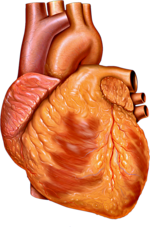 | Heart (redirect from Atria of the heart) lower part of the interventricular septum and crosses the interior space of the right ventricle to connect with the inferior papillary muscle. The right... 143 KB (16,888 words) - 19:48, 24 April 2024 |
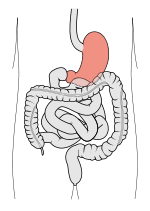 | Stomach (redirect from Body of stomach) outer longitudinal and the middle circular layer and is responsible for the innervation of both (causing peristalsis and mixing). The outer longitudinal layer... 47 KB (4,982 words) - 10:49, 23 April 2024 |
some maintain damage to the inferior pre-Rolandic motor strip (the motor cortex region responsible glossopharyngeal muscle control) is also necessary.[citation... 11 KB (1,445 words) - 16:43, 27 January 2024 |
 | Myocardial infarction (redirect from Inferior infarction) flow decreases or stops in one of the coronary arteries of the heart, causing infarction (tissue death) to the heart muscle. The most common symptom is retrosternal... 130 KB (13,860 words) - 04:10, 29 April 2024 |
Speech science (section Transmission of speech) production of speech is a highly complex motor task that involves approximately 100 orofacial, laryngeal, pharyngeal, and respiratory muscles. Precise and... 13 KB (1,547 words) - 12:10, 25 April 2023 |
 | Human brain (redirect from Embryonic development of the human brain) circle of Willis, with two branches, the anterior cerebral arteries emerging. These branches travel forward and then upward along the longitudinal fissure... 169 KB (18,798 words) - 18:30, 26 April 2024 |
 | Vitamin B12 deficiency (redirect from Causes of vitamin B12 deficiency) symptoms. In moderate deficiency, feeling tired, headaches, soreness of the tongue, mouth ulcers, breathlessness, feeling faint, rapid heartbeat, low blood... 118 KB (13,105 words) - 22:35, 25 April 2024 |
 | Malocclusion (redirect from Crowding of teeth) mouth breathing, and cleft lip and cleft palate. Muscle factors – the form and function of the muscles that surround the teeth. This could be impacted... 49 KB (6,096 words) - 01:59, 16 April 2024 |


